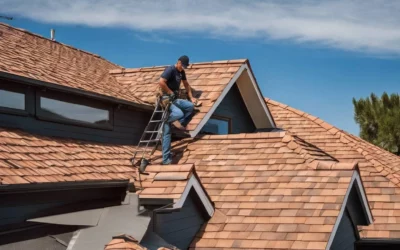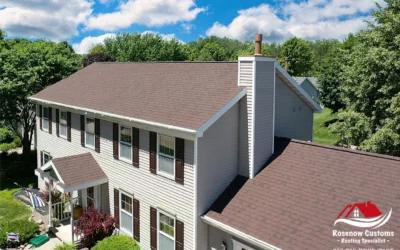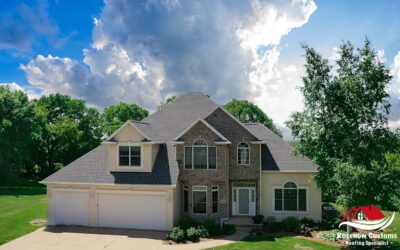When it comes to maintaining the integrity of your home, recognizing the signs that you need a shingle repair is crucial. This article will guide you through the key indicators of shingle damage, the common causes, and the benefits of timely repair. By understanding these aspects, you can ensure the longevity of your roof and safeguard your home against potential damage. Brought to you by Rosenow Customs LLC, experts in Residential Roof Repair.
Recognizing the Need for Shingle Repair
Preserving the lifespan of your roof and warding off severe damage hinges on timely shingle repair. The key to this lies in your ability to discern the subtle signs that your roof shingles are crying out for attention. These signs may manifest as visible wear and tear, granule loss, or water damage, each of which will be explored in detail. By honing your ability to spot these symptoms early, you can sidestep more expensive repairs or even a total roof replacement down the line.
Visible Wear and Tear
One of the most glaring signs that your shingles are in need of repair is visible damage. This can take on many forms, each telling a story of your roof’s condition. For example, cracked or curling shingles are a testament to age and harsh weather exposure. Similarly, shingles that have begun to blister or display signs of rot are a red flag signaling the need for repair.
Another tell-tale sign is the absence of shingles where there should be a continuous covering. This balding of your roof is a surefire indicator that repairs are in order. Shingles can be torn off by fierce winds and storms, or simply succumb to age and decay. This leaves your roof vulnerable to additional damages, such as water leaks, which can compromise the structural integrity of your home.
In conclusion, if your roof is exhibiting signs of visible wear and tear, such as missing, cracked, or curling shingles, it’s time to take immediate action. Keep a vigilant eye on your roof’s condition and don’t hesitate to enlist the services of a roofing professional if anything seems amiss. Early detection and intervention can save you money and ensure the longevity of your roof.
Granule Loss
The diminishment of granules on your shingles is a subtle yet significant sign of potential roof damage. Shingles are fortified with these minuscule particles, which serve as a shield against harmful UV rays and enhance their fire resistance. However, these granules can wear away over time due to weather exposure or physical harm, compromising your roof’s durability and lifespan.
The evidence of granule loss can be detected in several ways. One such sign is a noticeable alteration in your shingles’ hue. The granules often lend the shingles their distinct color, and as they erode, the shingles may take on a patchy or faded appearance.
Another telltale sign is the accumulation of granules in your gutters or downspouts. Rainwater can wash away loose granules, depositing them into your gutters. It’s important to note that a small number of granules in your gutters is normal, particularly after a new roof installation or severe weather event. However, if you consistently find a substantial amount of granules, it could be a warning that your shingles are reaching their functional limit.
Ignoring granule loss can lead to further complications, such as shingle cracking, curling, and eventually, leaks. If you spot any signs of granule loss, it’s advisable to consult a professional to restore your roof to its prime condition.
Water Damage
A robust roof serves more than just a barrier against wind and sunlight; it also plays a crucial role in keeping your home dry by preventing water intrusion. Consequently, any signs of water damage should be taken as a serious indication that your shingles may require repair or replacement.
One such sign is the presence of discoloration on your interior ceiling, often manifesting as brown or yellow water stains. These stains are a result of water seeping through compromised or missing shingles and infiltrating your home. The water tends to accumulate once it enters, leading to ceiling stains or even visible droplets if the leakage is substantial.
Another sign to look out for is water in your attic. After heavy rainfall, it’s advisable to inspect your attic for any signs of water or moisture. If you notice any dampness or pooling water, it could suggest a significant issue with your shingles.
Additional indicators of water damage include peeling exterior paint or damp, decaying insulation, suggesting that water is penetrating areas it shouldn’t.
Lastly, be on the lookout for signs of mold or persistent moisture in your home. A roof leak can create an ideal environment for mold growth, posing potential health risks and property damage.
In essence, water damage is not just a cosmetic concern – it jeopardizes your home’s structural integrity and your health. It’s crucial to stay alert for signs of water damage, and if detected, seek immediate professional intervention.
Understanding the Causes of Shingle Damage
Unraveling the mystery behind shingle damage is a crucial step in your journey to maintain a robust and long-lasting roof. While a myriad of factors can contribute to shingle deterioration, certain causes are more prevalent. This segment aims to illuminate these common culprits, equipping you with the knowledge to preemptively tackle potential issues and ensure your roof’s longevity. So, let’s embark on this enlightening journey to comprehend the primary triggers of shingle damage.
Weather Conditions
Mother Nature’s diverse moods can wreak havoc on your roof shingles, necessitating repairs. Let’s delve into some of these weather-induced factors:
Wind: Gale-force winds have the potential to lift shingle edges, creating an entry point for water and debris. This intrusion can result in moisture damage and gradual shingle deterioration.
Sun: Unrelenting exposure to the sun’s UV rays can expedite the aging process of your shingles. This continuous onslaught leads to color fading and brittleness, increasing the risk of cracks and breaks.
Rain: Persistent downpours can facilitate water seepage under the shingles, causing interior leaks. If overlooked, this can escalate into more serious issues like rot or mold growth.
Hail: Hail storms can inflict considerable damage to your shingles’ surface. The force of hail can strip away the granule surface of a shingle, leaving it vulnerable to the elements and shortening its lifespan.
Snow and Ice: Prolonged snow and ice accumulation on your roof can lead to the formation of ice dams—ice ridges that obstruct the drainage of melted snow. The trapped water can then infiltrate your home, causing extensive damage.
Comprehending the impact of various weather conditions on your roof shingles is instrumental in devising a maintenance plan and early detection of potential issues. Regular roof inspections following extreme weather events can help you spot and address any problems swiftly, preventing further damage.
Improper Installation
A significant factor contributing to shingle damage is improper installation, underscoring the importance of engaging skilled and certified roofing professionals. Let’s delve deeper into how installation errors can compromise your shingles.
Incorrect Nail Placement: A frequent installation error is improper nail placement. If nails aren’t accurately hammered into the shingles, they can loosen, leading to leaks or shingles being ripped off during strong winds.
Shingle Misalignment: Shingles need to be perfectly aligned for optimal performance. Misaligned shingles can create gaps for water to infiltrate beneath them, potentially damaging the roof deck and even causing leaks inside your home. Precise alignment ensures efficient water runoff from one shingle to the next, and finally off the roof.
Inadequate Ventilation: Ventilation is crucial for the longevity of your shingles. An improperly ventilated attic can cause excessive heat, leading to premature aging and cracking of your shingles.
Subpar Materials: Using inferior quality shingles or underlayment during installation can drastically reduce your roof’s lifespan, necessitating frequent repairs. It’s essential to ensure your contractor uses top-tier materials that can withstand your area’s weather conditions, thereby enhancing your roof’s durability.
By being aware of these potential installation pitfalls, you can ensure your roofing project is executed flawlessly, mitigating future damage risks. Always entrust your roofing tasks to seasoned professionals to uphold your roof’s integrity and extend its lifespan.
Benefits of Timely Shingle Repair
Maintaining your roof’s functionality and aesthetic appeal is paramount. Postponing repairs for damaged shingles can result in escalated costs and, even worse, substantial damage to your home. In this segment, we’ll delve into the advantages of addressing shingle damage promptly and professionally. This will provide a comprehensive understanding of how proactive measures can prevent future complications. Let’s explore the key benefits of timely shingle repair.
Cost Effectiveness
When it comes to maintaining your home, early intervention is key, especially when dealing with shingle damage. The financial implications of swift action can be significant, and here’s why:
Minimizing repair costs: Addressing minor shingle issues as they arise is far less costly than waiting for the damage to spread, which could necessitate a complete roof replacement.
Guarding your home’s interior: A damaged shingle can lead to leaks, threatening the integrity of your home’s interior elements such as drywall, insulation, and electrical systems. By acting quickly, you can avoid these additional repair costs.
Energy efficiency: Damaged shingles can compromise your home’s insulation, leading to increased heating and cooling costs. Prompt repairs help maintain your home’s energy efficiency, resulting in long-term savings on utility bills.
Extending your roof’s lifespan: Regular maintenance and quick repairs can add years to your roof’s life, postponing the substantial expense of a full roof replacement.
In essence, a small investment in shingle repair today can save you from substantial costs down the line, making it a financially savvy move for homeowners.
Preventing Further Damage
Ignoring shingle damage is a risky strategy that can lead to more serious problems. Here’s why it’s crucial to address these issues as soon as they’re spotted:
Water leakage prevention: Damaged shingles can provide an entry point for water, but quick repairs can seal these vulnerabilities, preventing potential leaks.
Averting structural damage: Water seeping through damaged shingles can reach the wooden structure of your home, causing rot or mold. By fixing the damaged shingle promptly, you can prevent this secondary damage.
Containing the problem: A single damaged shingle can have a domino effect, causing adjacent shingles to deteriorate. Timely repair can stop this spread, limiting the extent of the damage.
Weather protection: A robust roof is your home’s first line of defense against the elements. Any weakness, such as a damaged shingle, can expose your home to potential damage. Swift repairs ensure your home remains protected.
By addressing shingle damage as soon as it’s noticed, you can avoid these larger issues and maintain the structural integrity of your home. It’s a proactive strategy that pays dividends in the long run.
Maintaining Aesthetic Appeal
Beyond the practical benefits of shingle repair, such as cost savings and damage prevention, lies an often overlooked advantage – the enhancement of your home’s aesthetic appeal. Here’s a closer look at how timely shingle repairs can boost the visual charm of your property:
Enhancing Curb Appeal: The state of your roof plays a significant role in defining your home’s curb appeal. A roof with damaged or missing shingles can detract from your property’s overall look, creating an impression of neglect. Swift and efficient repairs ensure your home consistently presents its best face to the world, thereby elevating its curb appeal and adding to the visual harmony of your neighborhood.
Boosting Property Value: Considering a future sale or lease of your property? A well-maintained roof can be a powerful selling point. Prospective buyers and tenants often scrutinize the condition of the roof, and a roof boasting freshly repaired shingles can add considerable appeal, potentially driving up the property’s value or rental demand.
Preserving Uniformity: Shingles that are broken or discolored can disrupt the uniformity of your roof, resulting in an inconsistent pattern that may detract from your home’s exterior. Timely intervention to repair or replace these shingles can help maintain a consistent, appealing look for your home.
In sum, timely shingle repair is about more than just preserving your home’s structural integrity – it’s also about enhancing its aesthetic appeal. By keeping your property in top shape, you not only increase its potential value but also contribute to a well-kept neighborhood.
1. What are the indications that a roof needs shingle repair?
Obvious signs include curled, missing, or buckling shingles. Granules in the gutters, water stains inside and outside the home, and algae or moss growth on the roof also indicate a possible need for shingle repair.
2. Can worn-out or aged shingles lead to more extensive damage?
Yes, worn or aged shingles can lead to extensive damage if not repaired quickly. Leakages may develop, leading to water damage in ceilings, walls and foundations, or even lead to unhealthy mold growth.
3. How frequently should homeowners inspect their roofs for any sign of wear or damage?
Homeowners should perform a visual inspection of their roof’s condition at least twice a year, typically during fall and spring. These inspections can help identify potential problems early.
4. Can cracked or damaged shingles lead to higher utility bills?
Absolutely, damaged shingles can, over time, impact the efficiency of a home’s insulation, leading to an increase in heating and cooling costs.
5. Could shingles be repaired by homeowners, or is professional help necessary?
Minor roof repairs might be manageable by the homeowner with the right knowledge and tools. However, for large-scale damage, hiring professionals is advised to avoid further complications and ensure proper repair.
6. Are there certain types of shingles more prone to damages than others?
Indeed, some shingles are more damage-prone depending on their material, quality, and the type of weather in their location. For example, asphalt shingles may degrade faster in extreme temperatures compared to metal or slate shingles.




